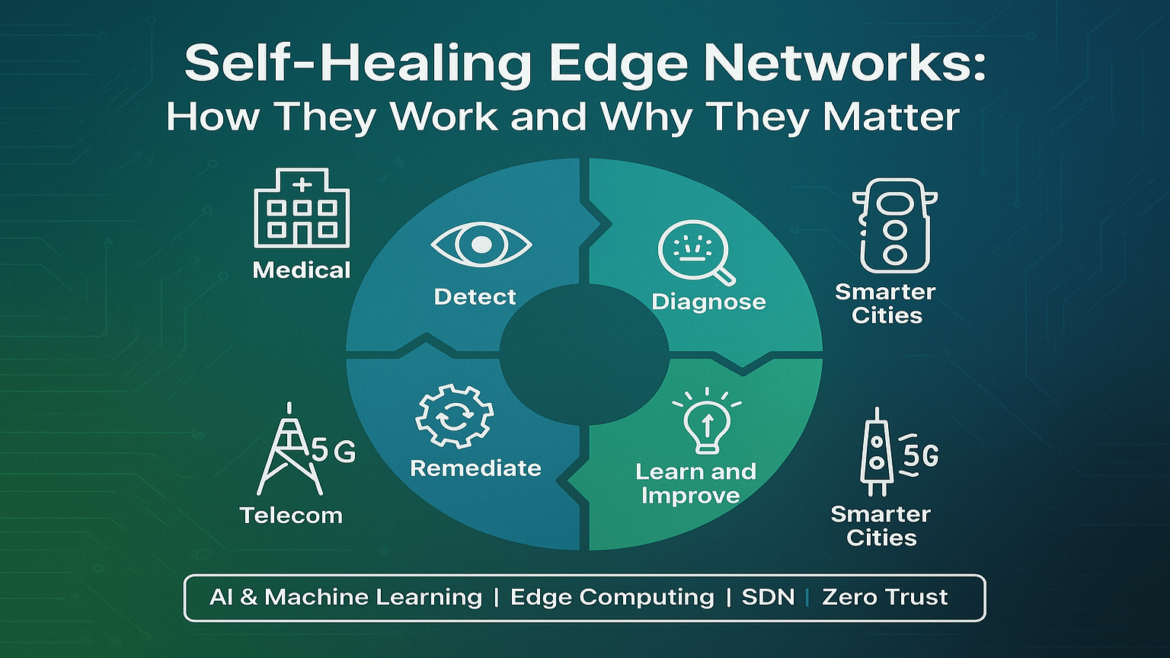Imagine a world where networks fix themselves, preventing outages, anxiety among IT personnel, and lost revenue. This is the potential of self-healing edge networks, a cutting-edge fusion of edge computing, AI, and machine learning. By 2025, these networks will be essential to the smooth operation of smart cities, healthcare, and other sectors. Let’s examine their operating mechanisms, real-world uses, and revolutionary possibilities.
Covered Contents
ToggleUnderstanding Self-Healing Edge Networks
Self-healing edge networks reside along the “edge” of a network, close to data sources like IoT devices or sensors. They don’t depend on conventional networks to apply AI to automatically detect, diagnose, and repair issues like traffic spikes, hardware crashes, or cyberattacks. For instance, in a smart factory, machine sensors share data through edge servers, enabling real-time repairs regardless of distant cloud infrastructure.
How They Work: A Four-Step Process
1️⃣ Detect the Problem
The network is constantly “monitoring” itself. It continually looks for any abnormal activity—such as a device malfunctioning or data going down the wrong path- so it can identify problems as soon as they occur.
2️⃣ Diagnose the Issue
When a problem is detected, the system determines what’s faulty. It analyzes previous data and intelligent algorithms (often fueled by AI) to learn the root cause of the problem and identify exactly where it’s located.
3️⃣ Remediate Automatically
Once the problem is diagnosed, the network automatically remedies it. For instance, it may divert data around the defective component or reboot a failing device—all without requiring human intervention.
4️⃣ Learn and Improve
Lastly, the network goes over what transpired and learns from the experience. This enables it to modify its future responses so that it avoids similar issues and gets stronger with time.
This basic process maintains the network intact, even in unexpected problems.
Examples of Self-Healing Edge Networks
Medical: Safeguarding Life-Saving Equipment:
For tracking IoT devices such as MRI scanners and infusion pumps, edge networks are employed by hospitals. The network immediately quarantines a pump if it suddenly attempts to connect to social media, which is a sign of a compromise. Thus, patient safety and data breaches are avoided.
Autonomous Vehicles: Avoiding Crashes:
Low-latency data exchange between self-driving vehicles and roadside sensors (RSUs) and edge servers is critical. A self-healing network decides in real time by foreseeing latency spikes and redirecting data to circumvent pauses (e.g., slowing down to avoid pedestrians).
Smarter Cities: Sustaining Traffic Flow:
Barcelona’s traffic lights and environmental sensors are controlled through edge networks. The network prevents city-wide congestion by redirecting information through proximate nodes when a sensor fails.
Telecom: Dependability of 5G:
Self-healing edge networks are used by telecom behemoths like IBM to handle 5G traffic spikes. To guarantee seamless video calls and streaming, AI proactively fixes hardware issues and redistributes bandwidth during busy hours. Retail: Enhancing the Experience for Customers:
Edge networks are used by retailers for inventory trackers and point-of-sale systems. When a camera system overloads the network, AI gives checkout traffic priority and keeps revenues from falling.
Core Technologies Behind the Magic
–AI and Machine Learning: Tools like AIOps employ data analysis to predict hardware failures or congestion.
–Edge Computing: By minimizing reliance on centralized clouds, local computing reduces latency.
-Software-defined networking (SDN) supports dynamic rerouting of traffic in case of cyberattacks.
–Zero Trust Security continuously authenticates devices and revokes access if it identifies suspicious behavior.
Benefits and Challenges
Advantages
-99.99% uptime for critical services such as hospitals.
-Through automated repairs, IT labor can be minimized by 40%.
-Ransomware can be stopped in under a second with instant threat isolation.
Challenges:
-AI and edge infrastructure have significant up-front costs.
-Issues with legacy hardware support.
-Privacy risks when sensitive information is processed locally.
The Future: Smarter, Faster, More Intuitive
By 2030, these networks will self-replicate backup nodes in case of attacks and self-optimize ecosystems that forecast disasters (e.g., pre-routing data before storms). By integrating AI assistants, IT professionals can use voice commands to regulate networks, such as prioritizing telehealth traffic during emergencies.
Conclusion
By combining automation, edge computing, and artificial intelligence, self-healing edge networks are revolutionizing entire sectors. Because they can prevent downtime, enhance security, and streamline operations, they are growing indispensable despite obstacles like expenses and old systems. According to the CTO of Nile, “The future isn’t just automated—it’s intuitive.”



